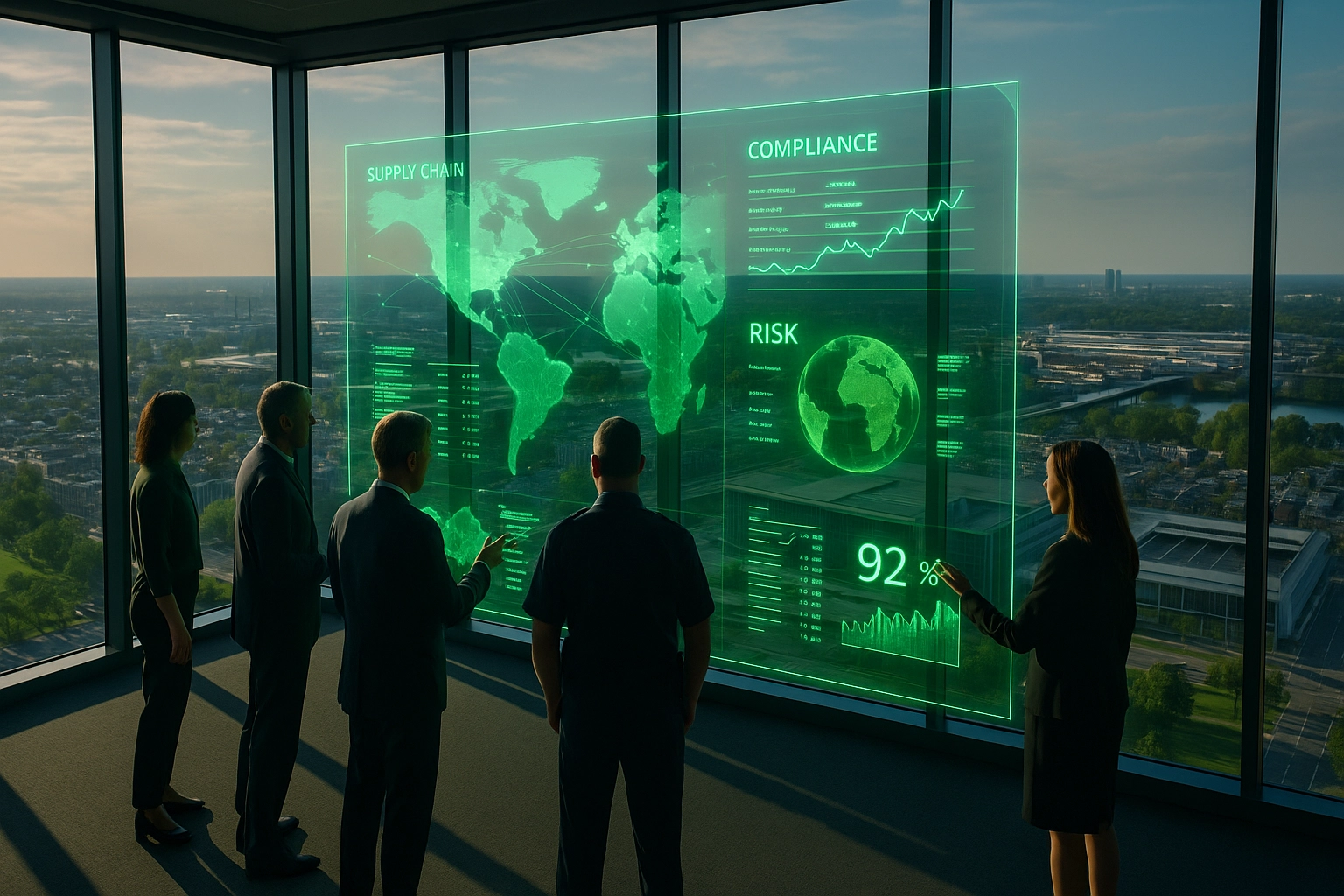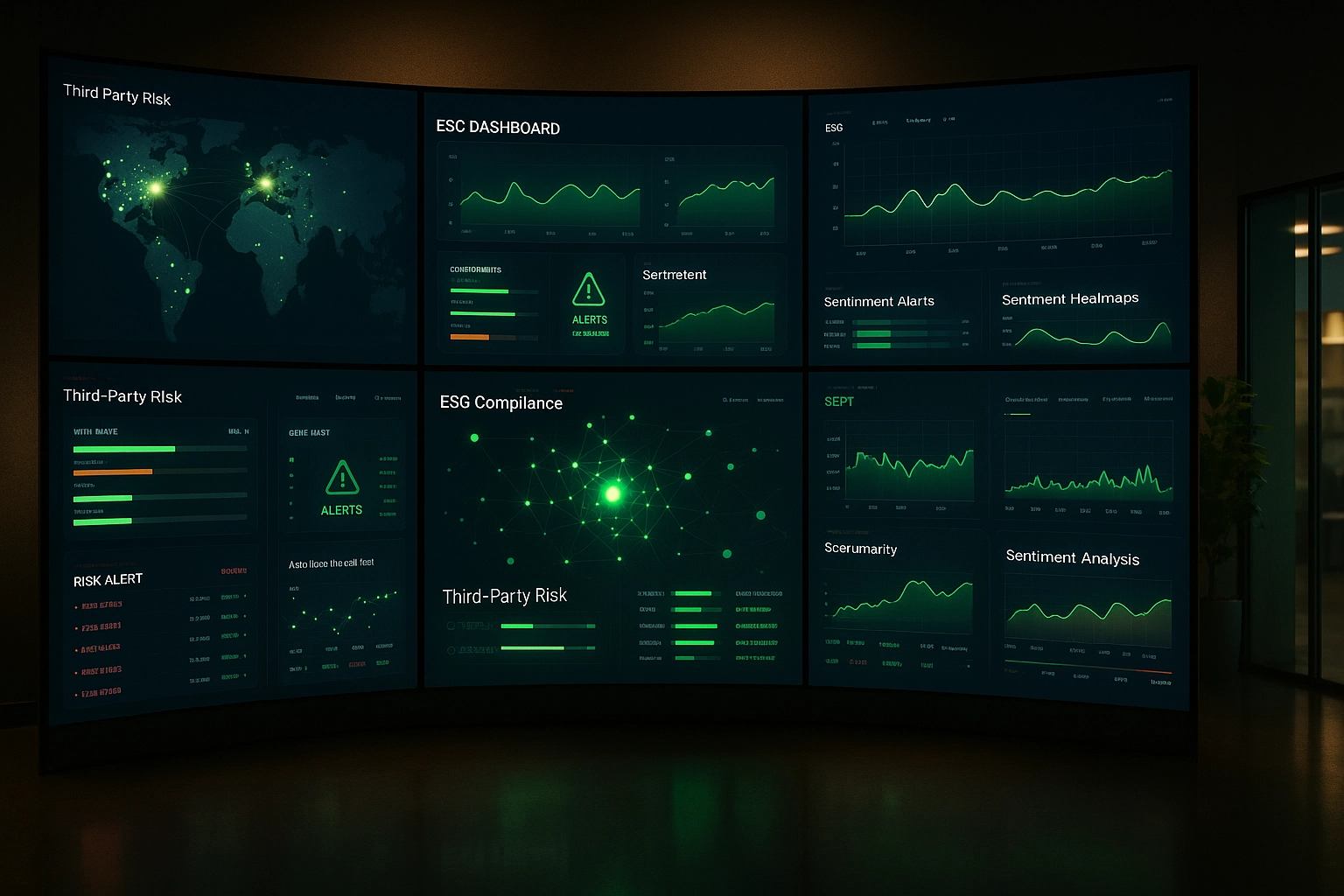Third-Party Risk Dashboard: Optimizing Management and Monitoring

In a context where supply chains and external partnerships are becoming increasingly complex, third-party governancehas emerged as a strategic priority for companies. According to a recent study, the global third-party risk management market is expected to reach USD 18.7 billion by 2030, driven by growing regulatory demands and increased reliance on external suppliers.
A third-party risk dashboard is a central tool in this approach, enabling organizations to visualize, analyze, and monitor in real time the risks associated with their partners. In the public sector, for example, such dashboards help implement SPASER, thus strengthening compliance and transparency.
This article explores how these innovative solutions are transforming third-party relationship management into a driver of operational resilience and informed decision-making.
Introduction to Third-Party Risk Management
Managing third-party risks has become a strategic priority for companies facing growing reliance on external partners. This process involves identifying, assessing, and monitoring risks related to suppliers, subcontractors, and other third parties. These risks go beyond financial aspects to include regulatory compliance, cybersecurity, and reputation.
In the public sector, for example, poor third-party management can lead to interruptions of essential services or breaches of transparency, as highlighted in a recent report on third-party risks in the field.
To meet these challenges, companies are adopting tools such as third-party risk dashboards, which centralize critical data and make it easier to analyze. These solutions not only detect high-risk areas quickly but also ensure proactive compliance in a constantly evolving regulatory environment.
Key Indicators to Include in a Third-Party Risk Dashboard
An effective third-party risk dashboard relies on carefully selected Key Performance Indicators (KPIs) and Key Risk Indicators (KRIs). These metrics help companies monitor, analyze, and mitigate risks associated with third parties while ensuring proactive compliance.
Compliance Rate: Measure the percentage of partners meeting regulatory and internal standards. In the public sector, for instance, this rate can reflect supplier adherence to GDPR requirements—a key criterion for local authorities.
Overall Risk Score: Assign an aggregated score based on criteria such as financial stability, compliance history, and cybersecurity. This score helps classify third parties by risk level (low, medium, high) and prioritize efforts.
Incident Frequency: Track the number of reported incidents by type (security, compliance, etc.). In industry, for example, this tracking can highlight critical vulnerabilities with ICPE (Classified Installations for Environmental Protection) suppliers.
Average Resolution Time: Calculate the average time needed to resolve an incident involving a third party. A reduction in this timeframe is often a key indicator of effective risk management.
Critical Dependency: Assess the level of dependence on certain strategic suppliers. In the construction sector, for example, this metric can identify providers whose absence would severely disrupt ongoing projects.
Integrating these indicators into a well-designed dashboard gives companies a clear, actionable view of third-party risks. It enables them to quickly identify critical areas and optimize their overall governance strategy.
To learn how Aprovall simplifies third-party governance through innovative solutions, visit our dedicated Aprovall360 page

Steering Tools for Risk Management
Effective third-party risk management relies on advanced steering tools that can centralize both internal and external data, automate processes, and deliver real-time actionable insights. These solutions allow companies to better assess, monitor, and mitigate risks associated with third parties while ensuring compliance.
Specialized Software for Centralized Management
Modern third-party monitoring tools offer advanced features such as automated assessments, continuous monitoring, and customized reporting. These solutions centralize critical data and simplify complex third-party governance processes.
In the public sector, for example, dedicated TPRM software can automate RGE assessments for local authorities, thus reducing administrative burdens while ensuring greater transparency. These tools leverage technologies such as artificial intelligence and machine learning to detect anomalies and provide real-time alerts, strengthening operational resilience.
By combining these features, such software becomes a strategic ally for companies seeking to optimize third-party risk oversight while complying with demanding frameworks like GDPR or DORA.
Continuous Monitoring and Real-Time Alerts
These tools integrate continuous monitoring systems that detect anomalies or compliance deviations as soon as they occur. This is particularly crucial in industry, where compliance incidents related to ICPE (Classified Installations for Environmental Protection) can have severe consequences on the supply chain.
Data Visualization for Informed Decision-Making
Interactive dashboards provide a clear visual representation of risk levels. Heat maps, for example, help quickly identify critical areas, while comparative charts show changes in compliance scores over time. These tools are essential for prioritizing actions and optimizing third-party governance.
By integrating these solutions, companies gain a consolidated, proactive view of third-party risks, enhancing their operational resilience and ability to meet growing regulatory demands.
Want to strengthen your third-party risk oversight?
Discover how Aprovall360 helps automate processes and optimize your governance.
Data Visualization for Better Understanding
Data visualization is a key lever for turning complex information into actionable insights, making decision-making easier in third-party risk control. By using the right visual tools, companies can not only identify critical areas but also communicate risks effectively to stakeholders.
Heat Maps for Risk Identification
Heat maps enable quick visualization of risk levels by region, sector, or category. In the public sector, for example, they can highlight local authorities where GDPR compliance is insufficient, helping to prioritize corrective actions.
Comparative Charts to Track Progress
Bar charts or trend curves are especially useful for observing changes in compliance scores or incident frequency over time. In industry, these visuals can help track the progress of REACH certifications among critical suppliers.
Interactive Tables for In-Depth Analysis
Interactive tables provide detailed views of key indicators, such as the average incident resolution time or dependency rates on certain third parties. These tools support deeper understanding and informed decision-making.
By integrating these visualization techniques into a third-party risk dashboard, companies improve their ability to anticipate and mitigate risks while optimizing their overall governance strategy.
Importance of Continuous Monitoring
Continuous monitoring is a cornerstone of third-party risk assessment, allowing companies to identify and mitigate risks in real time. Unlike periodic audits, this proactive approach provides constant visibility into evolving risks with external partners.
Early Detection for Better Responsiveness
Through automated tools, continuous monitoring quickly detects anomalies such as sudden drops in compliance or cybersecurity incidents. In the industrial sector, for example, real-time tracking can flag REACH compliance deviations, preventing costly supply chain interruptions.
Strengthening Regulatory Compliance
Regulatory frameworks like GDPR or DORA require rigorous third-party oversight. Continuous monitoring ensures that partners consistently meet these standards, minimizing legal and reputational risks. In the public sector, this type of monitoring is vital for maintaining constant compliance in public procurement.
An Economical and Efficient Strategy
By reducing reliance on manual, periodic audits, continuous monitoring optimizes resources while providing broader coverage. This approach also improves collaboration with third parties by fostering transparency and sustainable relationships.
By integrating continuous monitoring into their governance strategy, companies can anticipate emerging threats, adapt quickly to regulatory changes, and strengthen operational resilience.
Risk Analysis for a Proactive Strategy
Adopting a proactive strategy in third-party relationship management enables companies to anticipate potential threats, reduce disruptions, and strengthen operational resilience. Unlike reactive management, this methodology relies on in-depth data analysis and the development of preventive action plans.
Explore how Aprovall supports organizations in developing proactive strategies through centralized third-party management.
Early Identification of Emerging Risks
Proactive analysis starts with identifying risks before they materialize. In the public sector, for example, monitoring subcontractors can prevent delays in critical infrastructure projects through continuous compliance assessment.
Using Predictive Models
Modern risk analysis tools incorporate predictive models capable of spotting
Ready to transform your third-party management?
These articles might interest you
-
 08 July 2025Why integrate media monitoring into your third-party evaluation?SolutionsWith the rapid acceleration of digital information and the proliferation of media sources, real-time monitoring of your third-party partners’ media presence has become a critical strategic issue. Media monitoring is now an essential part of collaborative evaluation processes for any analyst seeking a comprehensive view of third-party risk. Whether the information is positive or negative, […]
08 July 2025Why integrate media monitoring into your third-party evaluation?SolutionsWith the rapid acceleration of digital information and the proliferation of media sources, real-time monitoring of your third-party partners’ media presence has become a critical strategic issue. Media monitoring is now an essential part of collaborative evaluation processes for any analyst seeking a comprehensive view of third-party risk. Whether the information is positive or negative, […]Read more
-
 23 April 2025ESG Platforms: Centralized Data for Sustainable PerformanceSolutionsThe growing interest of investors and businesses in Environmental, Social, and Governance (ESG) criteria comes with significant challenges in assessing third-party partners. According to the DLA Piper report, ESG evaluation of external providers has become critical, particularly with the CS3D directive (Corporate Sustainability Due Diligence) coming into force on July 25, 2024. This directive requires […]
23 April 2025ESG Platforms: Centralized Data for Sustainable PerformanceSolutionsThe growing interest of investors and businesses in Environmental, Social, and Governance (ESG) criteria comes with significant challenges in assessing third-party partners. According to the DLA Piper report, ESG evaluation of external providers has become critical, particularly with the CS3D directive (Corporate Sustainability Due Diligence) coming into force on July 25, 2024. This directive requires […]Read more
-
 19 January 2025Aprovall’s Strategic Challenges under CSRDSolutionsFor Aprovall, which supports over 430,000 third-party partners across Europe, operational resilience is a major strategic priority. A recent study reveals that 55% of companies subject to CSRD face difficulties in managing data quality and consistency. In response, Aprovall’s dual ISO 27001/27701 certification provides a robust framework for ESG data governance. In the social housing sector, sustainable performance requires an integrated value chain […]
19 January 2025Aprovall’s Strategic Challenges under CSRDSolutionsFor Aprovall, which supports over 430,000 third-party partners across Europe, operational resilience is a major strategic priority. A recent study reveals that 55% of companies subject to CSRD face difficulties in managing data quality and consistency. In response, Aprovall’s dual ISO 27001/27701 certification provides a robust framework for ESG data governance. In the social housing sector, sustainable performance requires an integrated value chain […]Read more
-
 14 February 2025Supply Chain and Cyber Risks: How to Protect Your Supply Chain?SolutionsThe digital transformation of supply chains creates new opportunities but also exposes organizations to growing vulnerabilities. In 2025, third-party compliance assessment and management becomes a major strategic issue as 45% of global organizations will have suffered supply chain attacks, three times more than in 2021. Given this shift, third-party governance has become a top priority, especially in critical sectors such as […]
14 February 2025Supply Chain and Cyber Risks: How to Protect Your Supply Chain?SolutionsThe digital transformation of supply chains creates new opportunities but also exposes organizations to growing vulnerabilities. In 2025, third-party compliance assessment and management becomes a major strategic issue as 45% of global organizations will have suffered supply chain attacks, three times more than in 2021. Given this shift, third-party governance has become a top priority, especially in critical sectors such as […]Read more

